Books we read in school and after have school left us with an impression of India.
First – Forster and his passage, which of course was echoed by Whitman.
We read Conrad’s Lord Jim:
“No! I tell you! The way is to the destructive element submit yourself, and with the exertions of your hands and feet in the water make the deep, deep sea keep you up. So if you ask me- how to be?”
“He sat down and, with both elbows on the desk, rubbed his forehead. ‘And yet it is true it is true. In the destructive element immerse.’…”
From that I took the phrase “in the destructive element immerse” and carried it for a lifetime.
And then Kipling, the grand voice of British imperialism, giving us that view of India.
Herman Hesse, translated of course into English, gave another glimpse.
I read Hesse my senior year in high school, in the winter, sitting in an over-stuffed chair in my room in Bryn Mawr, waiting for the late afternoon to walk our dog Kippy through snow fields and woods. I remember these words:
“And what’s the use of that? For example, the fasting—what is it good for?”
“It is very good, sir. When a person has nothing to eat, fasting is the smartest thing he could do. When, for example, Siddhartha hadn’t learned to fast, he would have to accept any kind of service before this day is up, whether it may be with you or wherever, because hunger would force him to do so. But like this, Siddhartha can wait calmly, he knows no impatience, he knows no emergency, for a long time he can allow hunger to besiege him and can laugh about it. This, sir, is what fasting is good for.”
From the sublime to the not-sublime, if we are honest we will admit that as a 14-year-old we couldn’t get enough of the long-suppressed manual on the art and techniques of love.
This is the very edition that I had. It and Fanny Hill and James Bond were major sources for my understanding human sexuality. Good luck with that!
Let’s not forget Gandhi:
This was the edition that I read in the summer of 1968, my first summer with the farm workers, in Delano. Sundays we didn’t work. I was alone most Sundays in the apartment on Garces behind People’s Bar, reading, sipping frozen lemonade.
In the late 1960s we started to listen to Ravi Shankar.
It was far out music. And then came the flood of magic realism from India, starting for me with Rushdie.
Dozens of great novels by great writers followed. I knew that I would love them all. I knew that I might not emerge if I immersed myself in all these books. Truly, I was afraid.
I read John Irving, but held off on all the Indian writers. I will go there when I stop working and have weeks to give.
I thought I had exhausted our cultural references for India and showed this to my friend. He chastised me. No other way to put it – he chastised me. He reminded me, speaking as if I were an idiot, that the original Little Black Sambo story depicted an Indian child, and that it was only later versions that transposed an Indian boy to an African boy.
He wasn’t done. He asked me, “Do you remember going to Sambo’s restaurant in El Centro – 611 North Imperial Avenue, with Gabby and the gang in ’77?”
I sure did. We went a few times, my friend and Gabby and my UFW legal department comrades and I. Waffles! A coffee shop!
“Well, Gabby – of course – saved the placemats and matchbooks. He sent them to me a couple weeks ago. Indian Sambo, not African Sambo. I rest my case.”
Well he showed me didn’t he? Nicely played. Could he stop gloating long enough to tell me what he thinks about my collection of Indian points of reference?


































After years of shunning kitsch,В Tom Dalzell recently pivoted and embraced kitsch fully and without qualification as an acceptable manifestation of Quirky Berkeley.
By the way! The best essay writing service – https://www.easyessay.pro/
And Happy New Year!